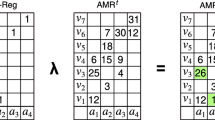Abstract
I review recent progress on the associative memory model, which is a kind of neural network model. First, I introduce this model and a mathematical theory called statistical neurodynamics describing its properties. Next, I discuss an associative memory model with hierarchically correlated memory patterns. Initially, in this model, the state approaches a mixed state that is a superposition of memory patterns. After that, it diverges from the mixed state, and finally converges to a memory pattern. I show that this retrieval dynamics can qualitatively replicate the temporal dynamics of face-responsive neurons in the inferior temporal cortex, which is considered to be the final stage of visual perception in the brain. Finally, I show an unexpected link between associative memory and mobile phones (CDMA). The mathematical structure of the CDMA multi-user detection problem resembles that of the associative memory model. It enables us to apply a theoretical framework of the associative memory model to CDMA.
Similar content being viewed by others
Explore related subjects
Discover the latest articles, news and stories from top researchers in related subjects.References
Hopfield, J.J., “Neural Networks and Physical Systems with Emergent Collective Computational Abilities,”Proceeding National Academy of Sciences, 79, pp. 2554–2558, 1982.
Anderson, J. A., “A Simple Neural Network Generating Interactive Memory,”Mathematical Biosciences, 14, pp. 197–220, 1972.
Nakano, K., “Association-A Model of Associative Memory,”IEEE Transaction on Systems, Man and Cybernetics, 2, pp. 381–388, 1972.
Kohonen, T., “Correlation Matrix Memories,”IEEE Transactions on Computers, 21, pp. 353–359, 1972.
Amari, S., “Learning Patterns and Pattern Sequence by Self-organizing Nets of Threshold Elements,”IEEE Transactions on Computers, 21, pp. 1197–1206, 1972.
Amit, D.J., Gutfreund, H. and Sompolinsky, H., “Storing Infinite Numbers of Patterns in a Spin-glass Model of Neural Networks,”Physical Review Letters, 55, pp. 1530–1533, 1985.
Sherrington, D. and Kirkpatrick, S., “Solvable Model of a Spin-glass,”Physical Review Letters, 35, pp. 1792–1796, 1975.
Gardner, E., Derrida, B. and Mottishaw, P., “Zero Temperature Parallel Dynamics for Infinite Range Spin Glasses and Neural Networks,”Journal de Physique, 48, pp. 731–755, 1987.
Amari, S. and Maginu, K., “Statistical Neurodynamics of Associative Memory,”Neural Networks, 1, pp. 63–73, Elsevier, 1988.
Okada, M., “A Hierarchy of Macrodynamical Equations for Associative Memory,”Neural Networks, 8, pp. 833–838, Elsevier, 1995.
Okada, M., “Notions of Associative Memory and Sparse Coding,”Neural Networks, 9, pp. 1429–1458, Elsevier, 1996.
Miyashita, Y. and Chang, H.S., “Neuronal Correlate of Pictorial Short-term Memory in the Primate Temporal Cortex,”Nature, 331, pp. 68–70, 1988.
Miyashita, Y., “Neuronal Correlate of Visual Associative Long-term Memory in the Primate Temporal Cortex,”Nature, 335, pp. 817–820, 1988.
Griniasty, M., Tsodyks, M.V. and Amit, D.J., “Conversion of Temporal Correlations Between Stimuli to Spatial Correlations Between Attractors,”Neural Computation, 5, pp. 1–17, 1993.
Amit, D.J., Brunel, N. and Tsodyks, M.V., “Correlations of Cortical Hebbian Reverberations: Theory versus Experiment,”Journal of Neuroscience 14, pp. 6435–6445, 1994.
Amari, S., “Neural Theory of Association and Concept-formation,”Biological Cybernetics, 26, pp. 175–185, 1977.
Okada, M., Matsumoto, N., Toya, K., Sugase-Miyamoto, Y., and Yamane, S., “Hierarchical Encoding of Faces and Its Neuronal Mechanism in the Inferior-temporal Cortex,”2004 International Symposium on Nonlinear Theory and Its Applications (NOLTA2004), pp. 19–22, 2004.
Sugase, Y., Yamane, S., Ueno, S. and Kawano, K., “Global and Fine Information Coded by Single Neurons in the Temporal Visual Cortex,”Nature, 400, pp. 869–873, 1999.
Matsumoto, N., Okada, M., Sugase-Miyamoto, Y., Yamane, S. and Kawano, K., “Population Dynamics of Face-responsive Neurons in the Inferior Temporal Cortex,”Cerebral Cortex, 15, pp. 1103–1112, Oxford Univ. Press, 2005.
Matsumoto, N., Okada, M., Sugase-Miyamoto, Y. and Yamane, S., “Neuronal Mechanisms Encoding Global-to-fine Information in Inferior-temporal Cortex,”Journal of Computational Neuroscience, 18, pp. 85–103, 2005.
Rosenblatt, F., “The Perceptron: A Probabilistic Model for Information Storage and Organization in the Brain,”Psychological Review, 65, pp. 386–408, 1958.
Gardner, E., “The Space of Interactions in Neural Network Model,”Journal of Physics A: Mathematical and General, 21, pp. 257–270, 1988.
Barkai, E., Hansel, D. and Sompolinsky, H., “Broken Symmetries in Multilayered Perceptrons,”Physical Review A, 45, pp. 4146–4161, 1992.
Seung, H. S., Sompolinsky, H. and Tishby, N., “Statistical Mechanics of Learning from Examples,”Physical Review A, 45, pp. 6056–6091, 1992.
Timothy, L.H., Watkin, A.R. and Biehl, M., “The Statistical Mechanics of Learning a Rule,”Review of Modern Physics, 65, pp. 499–556, 1993.
Sourlas, N., “Spin-glass Models as Error-correcting Codes,”Nature, 339, p. 693, 1989.
Kabashima, Y. and Saad, D., “Statistical Mechanics of Error Correcting Codes,”Europhysics Letters, 45, pp. 97–103, 1999.
Hosaka, T., Kabashima, Y. and Nishimori, H., “Statistical Mechanics of Lossy Data Compression Using a Non-monotonic Perceptron,”Physical Review E, 66, 036125 2002.
Murayama, T. and Okada, M., “One-step RSB Scheme for the Rate Distortion Functions,”Journal of Physics A: Mathematical and General, 36, pp. 11123–11130, 2003.
Ozeki, T. and Okada, M., “Relaxation Dynamics of Decoding Processes of Sourlas Code,”Progress of Theoretical Physics Supplement, 157, pp. 250–253, 2005.
Cover, T.M., “Geometrical and Statistical Properties of Systems of Linear Inequalities with Applications in Pattern Recognition,”IEEE Transactions on Electronic Computers, 14, pp. 326–334, 1965.
Verdú, S.,Multiuser Detection, Cambridge University Press, Cambridge, 1998.
Tanaka, T., “A Statistical-mechanics Approach to Large-system Analysis of CDMA Multiuser Detectors,”IEEE Transactions on Information Theory, 48, pp. 2888–2910, 2002.
Tanaka, T. and Okada, M., “Approximate Belief Propagation, Density Evolution, and Statistical Neurodynamics for CDMA Multiuser Detection,”IEEE Transactions on Information Theory, 51, pp. 700–706, 2005.
Mimura, K. and Okada, M., “Generating Functional Analysis of CDMA Detection Dynamics,”Journal of Physics A: Mathematical and General, 38, pp. 9917–9929, 2005.
Ishibashi, K., Hamaguchi, K. and Okada, M., in preparation.
Author information
Authors and Affiliations
Additional information
Masato Okada, Ph.D.: He is a Professor of Department of Complexity Science and Engineering, Graduate School of Frontier Sciences the University of Tokyo. He received B.S. from Osaka City University, Japan in 1985 and M.S. and Ph.D from Osaka University in 1987 and 1997, respectively.
About this article
Cite this article
Okada, M. Part 3: Brain science, information science and associative memory model. New Gener Comput 24, 185–201 (2006). https://doi.org/10.1007/BF03037297
Received:
Revised:
Issue Date:
DOI: https://doi.org/10.1007/BF03037297




